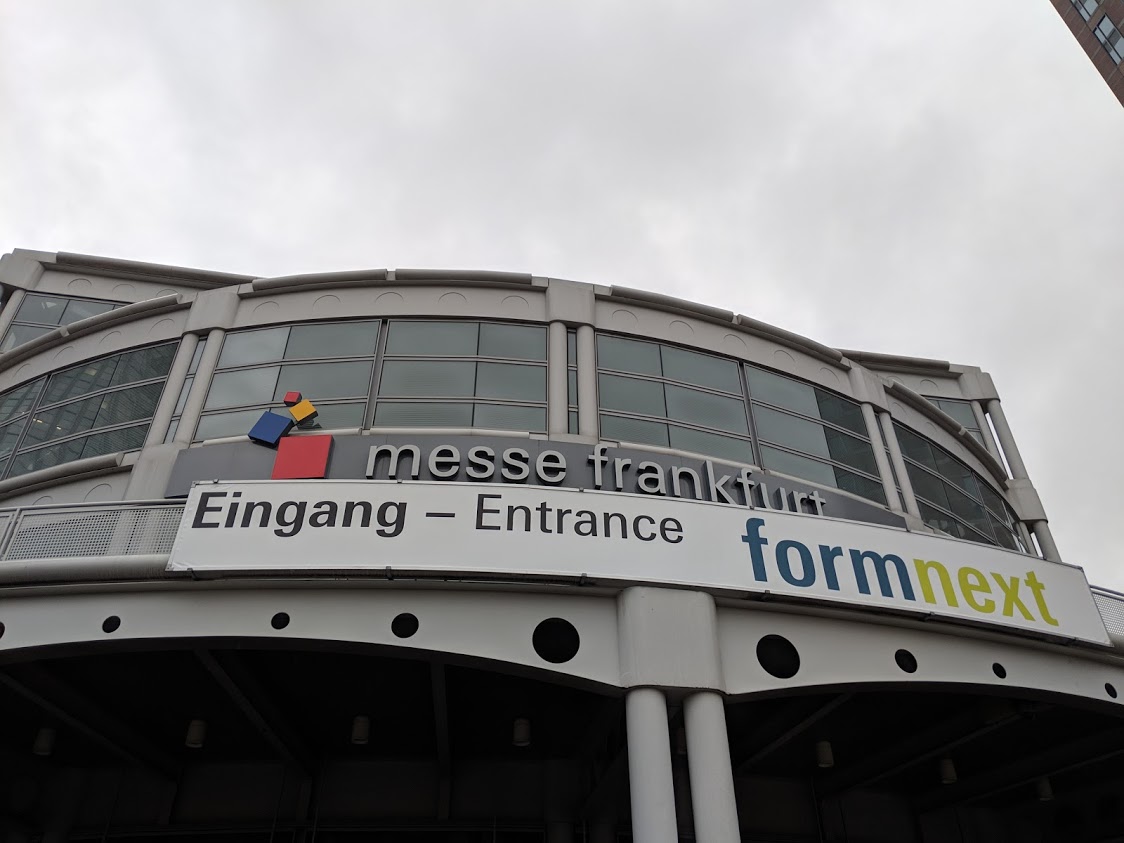![[Image: Fabbaloo]](https://fabbaloo.com/wp-content/uploads/2020/05/IMG_20181113_091131_img_5eb0a28929ffd.jpg)
26,919 visitors and 632 exhibitors can’t be wrong: formnext 2018 has made Frankfurt The Place To Be in additive manufacturing each November.
Official numbers are in, and this year’s event was bigger than ever (as expected). I believe it; I logged around seven walking miles each of the four days of the event, and the bulk of that was simply going booth to booth for interviews. I use “simply” loosely, as interviews took place throughout (and without) Frankfurt Messe, as Halls 3.0 and 3.1 were both filled with exhibitors’ booths, and press conferences in meeting rooms and in area locales kept covering media on our feet to get everywhere to see everything.
For my part, that meant 44 meetings/scheduled interviews, 7 after-hours events, and wildly sore feet and back.
Fortunately, Team Fabbaloo was on the ground in Frankfurt en masse (as it were), as Kerry (our own General Fabb) and Marney made the rounds to far more booths to see more companies and innovations than I was able to fit into my live-by-it spreadsheet.
We’ll all have much more to come in the following days and weeks (months? There was a lot to see).
With in-depth interviews revealing much in the way of new developments — and off-the-record conversations hinting at much, much more to come — we had the opportunity to get a good handle on the realistic shape of additive manufacturing as it stands as 2018 winds down.
A few trends were readily apparent.
Serial Production
![Dr. Adrian Keppler (right) and EOS introduce LaserProFusion technology for scale polymer 3D printing [Image: Fabbaloo]](https://fabbaloo.com/wp-content/uploads/2020/05/IMG_20181113_145250_img_5eb0a289b7875.jpg)
This is the Big One, the messaging at near every press conference and many an interview: additive manufacturing is making its way into actual, viable production scale.
3D printing is already — and is more thoroughly becoming — a mass manufacturing technology suite.
With announcements focusing on speed, scale, and quality, serial production was in the spotlight.
Higher-quality materials (and higher-temperature print beds) are enabling higher-quality builds. Users are increasingly able to meet reliable, repeatable quality with 3D printing technologies, and hardware, software, and materials manufacturers are introducing workable ecosystems set to scale solutions on both the metal and polymer sides.
Simulation
![Siemens execs focused on the digital twin in the journey toward industrializing additive manufacturing [Image: Fabbaloo]](https://fabbaloo.com/wp-content/uploads/2020/05/IMG_20181113_130726_img_5eb0a28a5235e.jpg)
As ecosystems continue to build up and solutions providers realize the increasing need for end-to-end strategies, simulation is taking its place in the spotlight.
Understanding what a build will entail prior to pressing ‘print’ and having a design endure — virtually — the conditions of its end use environment, including stress points and indications of wear, marks a major step forward to not only predictive capabilities but for the digital manufacturing techniques bringing them to fruition.
“Digital twin” was an oft-heard phrase, as creating a simulated likeness of a planned end product offers a strong look into the capabilities of physical output.
Collaboration
![Speaking on issues of digitization in manufacturing with GKN [Image: Fabbaloo]](https://fabbaloo.com/wp-content/uploads/2020/05/image_from_ios_img_5eb0a28aeb0c4.jpg)
Every show — every show — in this industry features significant looks into collaborative efforts, as joint ventures, strategic partnerships, reseller channels, and other relationships continue to push 3D printing into its next evolutionary stages.
Formnext had (more than) its fair share of collaboration-based announcements, but beyond that were demonstrations of larger views.
On the final day of the show, I accepted an invitation from GKN Additive to join the panel discussion at their Thought Leader Talk discussion: “How can 3D printing shape your business?” Alongside representatives from GKN Powder Metallurgy, 3YOURMIND, Deutsche Bahn, and PostNord, I appreciated the opportunity to discuss challenges and opportunities for additive manufacturing in the 21st century business environment. GKN’s Digital Café, held each day of the event, brought together a diverse series of thought leaders from across the industry together in conversation. This type of collaboration, featuring insights from hardware, software, materials, end users, and industry analysts, showcased the collaborative spirit of the industry: we’re all in this together.
Announcements made throughout the week, such as that between Materialise, BASF, and Essentium, underscored the seriousness of such messaging.
No one company holds the solution. More and more (and ever more realistically), participants in this industry are understanding that.
2018
So where are we?
Before this year’s event was even especially close to happening, announcements had rolled out that the 2019 formnext would be even larger, taking up more room in larger halls at Frankfurt Messe and hosting more (more!) exhibitors. This announcement came on the heels of the numbers for the 2018 event, the largest and most international yet for formnext, and serves to underscore a critical reality:
Where we are is a stepping stone.
Where we are is another step forward on a journey with a long way ahead of it.
Basically: you think this is big? You haven’t seen anything yet.











The fate of major 3D printing conferences in 2020 is unclear with the ongoing virus outbreak. We have thoughts on what it could mean.